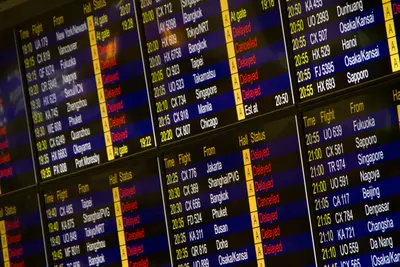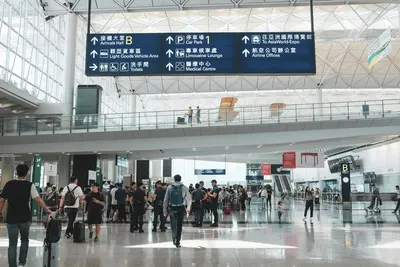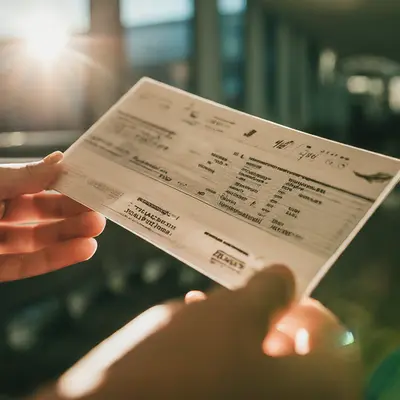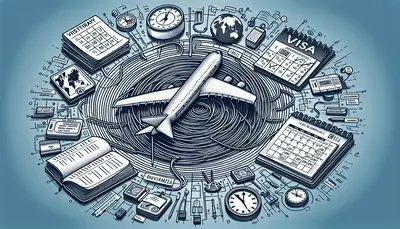What is a Flight Itinerary?
A flight itinerary outlines your travel plans, including flights and destinations. It’s essential for planning trips, making reservations, and visa applications. In this article, we will discuss “what is a flight itinerary” and its key elements.
Key Takeaways
-
Flight itineraries are essential documents that outline travel schedules, aiding in reservations, visa applications, and mitigating travel hassles.
-
Key components of a flight itinerary include flight numbers, departure and arrival airports, and precise travel dates and times, ensuring an organized travel plan.
-
Different types of flight itineraries, such as one-way, round-trip, open-jaw, and multi-city, cater to various travel needs, offering flexibility and suitability for different travel scenarios.
What Is a Flight Itinerary?

A flight itinerary can be a proposed route before booking or a confirmation of travel plans after booking. It outlines the schedule of a trip, including:
-
Destinations from start to finish
-
Modes of Transportation
-
Key dates and times
-
Full names of all travelers
This document aids in streamlined travel planning, assisting travelers in making arrangements like hotel reservations, car rentals, and airport pickups.
Flight itineraries play a significant role in visa applications. They help avoid hassles and inconveniences during air travel and aid in analyzing unforeseen circumstances. The specifics of a flight itinerary can vary significantly depending on the traveler’s needs and preferences.
When applying for a visa, a flight itinerary serves as a reserved plan to and from the destination country, which is often required by embassies.
Key Components of a Flight Itinerary

A detailed flight itinerary encompasses several vital components that facilitate a seamless travel experience. These components are flight numbers, departure and arrival airports, and accurate travel dates and times. Together, they provide a comprehensive overview of your journey, ensuring you can plan every aspect of your trip with confidence.
Flight Numbers
Flight numbers are important for identifying specific flights and are allotted by airlines to distinguish between routes. These numbers help passengers locate their flight’s gate on airport monitors and can indicate the operating airline and the route’s origin and destination. In some cases, flight numbers commemorate special events or historical moments, and they may change if an airline alters a route due to incidents or operational changes.
Departure and Arrival Airports

Being aware of the departure and arrival airports forms an integral part of flight itineraries. This information helps determine the route, necessary fuel, and alternate airports if needed. Additionally, passengers can plan their ground transportation more effectively when they know these airports.
Departure and arrival airport codes are often included to avoid confusion between cities with multiple airports.
Travel Dates and Times
Precise travel dates and times are integral to a flight itinerary. They help in:
-
Planning and ensuring flight availability
-
Preventing schedule conflicts
-
Helping travelers coordinate their trips
-
Accurate dates and times are crucial for proper scheduling, including accounting for time zone differences.
It is important to note that travel dates and times are always represented in local time to that destination, so don't worry if the time difference looks off based on the duration of the flights, you have to factor in the time zone difference.
Different Types of Flight Itineraries

Different types of flight itineraries exist, catering to specific travel needs. These include:
-
One-way: a single journey from one city to another
-
Round trip: a journey with a fixed schedule, departing from and returning to the same city
-
Open-jaw: a journey where the traveler flies into one city and departs from another, without returning to the original city
-
Multi-city: a complex travel plan involving multiple destinations
Each type caters to different travel requirements, allowing travelers to choose the itinerary that best suits their needs.
One-Way Flight Itinerary
A one-way flight itinerary is a travel plan for a single flight between two destinations with no return date. This type of itinerary offers flexibility for unplanned trips and can include details on stopovers and connecting airports.
One-way flights, including those with connecting flights, are often cheaper and best for travelers who plan to decide on their return journey at a later date.
Round Trip Flight Itinerary
A round-trip flight itinerary involves flying to a destination and then returning. This round trip itinerary includes details about departure and arrival from/to different locations, as well as gate and terminal information. Round-trip flights are generally more economical for pre-planned tours and are ideal for fixed schedules such as business meetings or events.
Booking round-trip flights has several advantages:
-
It avoids the hassle of securing return flights separately
-
It is suitable for individuals with a set return date
-
In specific cases before the visa interview, a round-trip flight ticket can be requested by embassies or consulates.
A round-trip flight reservation also demonstrates the departure and arrival to the traveler’s home country, serving as convincing proof that they will return.
Open-Jaw Itinerary
An open-jaw itinerary is created when the return origin and destination differ from the initial departure points. This type of itinerary is ideal for travelers flying into one city and departing from another without returning to the original city.
Open-jaw itineraries allow travelers to depart from one city and return to another, providing more flexibility.
Multi-City Itinerary
A multi-city itinerary involves booking flights to more than two destinations using a multiple airlines itinerary. This type of itinerary is designed for complex travel plans, allowing travelers to visit multiple destinations within a single trip.
Multi-city itineraries simplify planning by allowing bookings for several destinations at once.
Flight Itinerary vs Flight Ticket

Even though a flight itinerary gives a synopsis of travel plans, it should not be confused with a flight ticket. A flight itinerary outlines your travel schedule, including flight details, departure and arrival airports, and travel dates and times. It helps you make arrangements and plan your trip effectively.
On the other hand, a flight ticket is a document issued by an airline or travel agency that confirms a paid seat on a specified flight. This document serves as proof of booking and seat reservation. While a flight itinerary is essential for travel planning, a plane ticket confirms your seat and purchase. Understanding the difference between a flight itinerary and a flight ticket can help avoid confusion and ensure smooth travel planning.
How to Get a Flight Itinerary Without Full Payment
Several methods exist for obtaining a flight itinerary without making a full payment. These include using travel agents, airline hold options, and purchasing refundable tickets. These methods allow travelers to reserve their flight plans without committing to full payment, providing flexibility and reducing financial risk in case of visa rejection.
Using Travel Agents
A travel agent can assist in making a flight ticket reservation and reserving flight itineraries without full payment, making travel planning more flexible. They can hold a travel ticket for a fee, usually around 10% of the fixed ticket price, allowing travelers to reserve their plans without immediate financial commitment.
Airline Hold Options
Some airlines offer hold options for reservations, allowing passengers to reserve a fare for a set time for a fee. United Airlines, for example, provides a service called FareLock, which allows customers to purchase a reserved fare for either three or seven days. This option provides flexibility in planning and securing flight itineraries without full payment.
Refundable Tickets
Refundable tickets, though slightly more expensive, allow passengers to:
-
Get their money back if plans change
-
Secure a flight itinerary for visa applications, including a return flight ticket
-
Have the flexibility to cancel or change their plans without financial loss
This option is beneficial for travelers who need these benefits.
Importance of a Flight Itinerary for Visa Applications

Flight itineraries play a significant role in visa applications as they furnish proof of onward travel and aid in determining visa validity. Consular officers use flight itineraries to verify the applicant’s travel plans, ensuring they do not intend to stay illegally in the destination country after the visa expires.
Proof of Onward Travel
A flight itinerary can act as proof of onward travel, guaranteeing that the traveler will depart from the destination country. This requirement is crucial for visa applications as it assures the embassy that the traveler does not intend to stay illegally after their visa expires. Many countries, including Schengen visa member states, Canada, and Japan, require proof of onward travel when applying for a visa.
Dummy flight tickets are commonly used to show proof of onward travel, avoiding the financial risk of purchasing non-refundable tickets before visa approval.
Determining Visa Validity
Flight itineraries assist consular officers in determining the visa’s validity duration by offering clear information about the required number of stay days in the country. The detailed flight itinerary ensures that the travel dates align with the traveler’s plans, helping to determine the appropriate length of stay for the visa.
What Is a Dummy Flight Ticket?
A dummy flight ticket is essentially a round-trip flight reservation from and back to the original departure country, serving as a placeholder without actual payment. This type of reservation is often used for visa applications to show proof of travel plans without the financial risk of purchasing a non-refundable ticket before visa approval. Travel agents can assist in obtaining a dummy flight itinerary, providing a tentative plan that can later be converted into an actual ticket.
However, it is strongly advised against using fake flight reservation websites or generators to create a dummy ticket for visa applications. Such practices can lead to visa application denial and potential issues with future applications. Always use legitimate services to obtain a dummy flight ticket to ensure compliance with visa requirements.
Common Mistakes to Avoid When Booking a Flight Itinerary
Opting for the cheapest fare without factoring in additional fees for baggage, seat selection, or ticket changes can ultimately lead to higher costs. It’s essential to read all the details and be aware of any extra charges that may apply. Another common mistake is not being flexible with travel dates, which can prevent you from finding cheaper flights available on less popular weekdays.
Ignoring budget airlines in flight searches can result in missing out on lower fare options. Booking flights too early or too late can also lead to higher prices; the best deals are often found around three weeks before departure. Additionally, purchasing travel insurance can reimburse you for tickets if you have to cancel the trip. Avoid purchasing tickets over the weekend when fewer deals are available and consider early morning flights for marginal savings and fewer delays.
How to get a Flight Itinerary
Now that the concept of a flight itinerary is clear, let’s understand how to procure one for a visa application. The visa application process can be stressful, especially for first-timers. Flight reservations are essential documents required for many visa applications. A flight itinerary for a visa application is a PDF-formatted document that includes the applicant’s full name, date, and flight information to the destination.
Embassies caution against buying full flight tickets before visa approval due to the high rates of visa denials and potential application delays. Instead, you can use services that offer flight reservations for visa applications, which provide the necessary documentation without the financial risk. This approach ensures you have a confirmed flight reservation that meets visa requirements while allowing you the flexibility to adjust your plans if needed.
Summary
Understanding flight itineraries is crucial for smooth travel planning and successful visa applications. A flight itinerary outlines your travel schedule, including destinations, transportation, accommodation, and planned activities. It helps avoid hassles during air travel, supports visa applications, and ensures you can confidently plan every aspect of your trip.
Whether you’re booking a one-way, round trip, open jaw, or multi-city itinerary, knowing the key components and how to obtain a flight itinerary without full payment can save you time and money. Use this knowledge to navigate the complexities of air travel, ensuring a stress-free and enjoyable journey. Happy travels!
Frequently Asked Questions
What is a flight itinerary?
A flight itinerary is a detailed document containing your travel plans, such as destinations, flight details, and schedules, and is essential for travel planning and visa applications.
How can I get a flight itinerary without full payment?
You can obtain a flight itinerary without making full payment by using travel agents, utilizing airline hold options, or purchasing refundable tickets. These options allow you to secure a flight itinerary before paying in full.
Why is a flight itinerary important for visa applications?
A flight itinerary is important for visa applications because it serves as proof of onward travel and helps consular officers determine visa validity.
What is a dummy flight ticket?
A dummy flight ticket is a placeholder reservation often used as proof of reservation for visa applications. It does not require actual payment.
What are common mistakes to avoid when booking a flight itinerary?
When booking a flight itinerary, consider additional fees, check for flexible travel dates, consider budget airlines, and book at the right time to avoid common mistakes.



